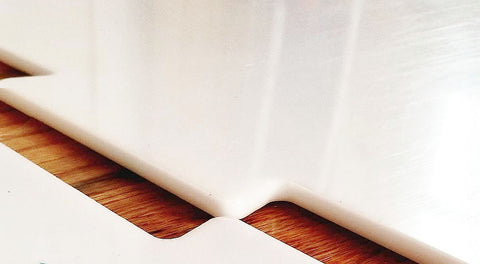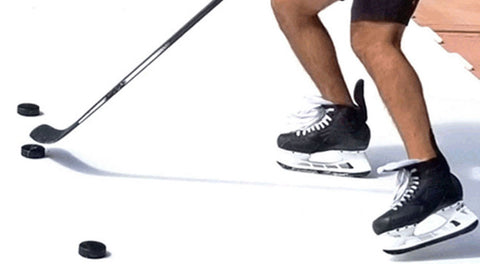What are synthetic ice tiles?
Synthetic ice tiles are square pieces of portable, polymer (flooring) material that can be assembled and used for ice skating with regular metal blade skates.
These are usually white or light blue in color with either a smooth or textured finish surface.
The first developed tiles were designed primarily for hockey shooting galleries and simple hockey stick-handling drills, not for skating.
OUR PICKS FOR THE BEST SYNTHETIC ICE TILES
Best Home Ice Tiles
Polyglide Home Ice Tiles
Best Overall
Polyglide Pro Ice Panels
In 2010, PolyGlide Ice developed the first infused skatable tiles for skaters which were later showcased on ABC's Shark Tank on December 9th, 2016 | See link below:

The best synthetic ice tiles are comprised of a high-grade polyethylene plastic, capable of withstanding sharp blade edges.
Most of today’s tiles have "dove-tailed" perimeter edges shaped like puzzle pieces similar to rubber flooring tiles.
The skating tiles are placed on the floor, side-by-side, and can be assembled to form virtually any size skating surface you want.
A surface conditioner can be applied to further enhance the glide on any type of synthetic ice surface if desired.
Many of today's synthetic ice products come pre-infused with a slip agent, though not all are created equal or of the same grade polymer.
A standard PolyGlide Ice synthetic ice tile comes in a 2:1 sized ratio, for example, 24” x 48” (8 square feet per), with only a few needed to cover a substantial space for basic training.
To the average layperson, skating on something that’s not actual ice sounds crazy, yet the advantages of skating on synthetic ice are undeniable.
Here at PolyGlide Ice, we offer 4-Basic Starter Kits that provide the most ice-like skating experience:
 WORTH EVERY PENNY!!! - Danielle / Verified Purchase
WORTH EVERY PENNY!!! - Danielle / Verified Purchase
This rink is perfect for off season training... Our son loves it and uses it daily. Huge hit when friends come over!!! Easy to set up and has multi purposes for dry land and ice time!!!! Worth every penny!
 SO MUCH FUN FOR OUR FAMILY - Kevin / Verified Purchase
SO MUCH FUN FOR OUR FAMILY - Kevin / Verified Purchase
We have been steadily growing our rink in the basement. Now up to 20 by 8. My 4 year old son learned to go from walking on the ice at 2 to flying around now at 4. My daughter son and I love inventing drills to challenge each other.
Now just have to figure out how to get rid of the lally column than is preventing further expansion.
 EXCELLENT CUSTOMER SERVICE AND PRODUCT - Steven B / Verified Purchase
EXCELLENT CUSTOMER SERVICE AND PRODUCT - Steven B / Verified Purchase
My son loves the tiles for dry land training. Excellent customer service also. I had a question about the tiles and someone who could help me answered the phone and took care of it promptly and professionally. I would recommend the product and the company.
 THIS IS A MUST HAVE! - Brent Bandy / Verified Purchase
THIS IS A MUST HAVE! - Brent Bandy / Verified Purchase
We put together a 8'x16' rink for Christmas last year for our kids (now age 3 and 6) and they absolutely love it! Being able to lace up or just play in socks (whenever they/we want) has introduced a new level of fun for our entire family!

How did we get here?
Irish playwright George Bernard Shaw once said:
“A man learns to skate by staggering about and making a fool of himself.
Indeed, he progresses in all things by resolutely making a fool of himself.”
When you first hit the ice, you do feel like a newborn foal trying to find its legs. But the feeling you get when you do is indescribable.
That’s why there are millions of figure skaters, hockey players, ice dancers, and speed skaters today.
Getting access to as much ice time as possible is really the only way to become an advanced skater.
However, with limited ice rinks available, this was once only possible for those who lived closest to the rink or in cold climate regions.
With synthetic ice tiles, ice skating, and training have become much more accessible and is the perfect "ice simulator" for off-ice training away from the rink.
The popularity of synthetic ice tiles is rising steadily, so much so that skaters can now easily create their own home ice flooring!
Perhaps you’re looking for a solution for your kids to have more time ice skating in a safe home environment.
Whatever the reason, synthetic ice tiles are becoming the go-to instead of building a refrigerated ice rink which is super costly.
Before you choose a synthetic ice provider, you must understand the pros and cons – the good, bad, and, yes, a little ugly truth – about this innovative product.
The Good: Advantages of synthetic ice tiles
So why choose synthetic ice?
There are some fantastic advantages that make these tiles a good choice for skaters at all levels.
These advantages include the following:

1. Anyplace, anywhere, at anytime
Synthetic ice tiles are durable and can withstand the elements.
That means you can use them inside (like a spare room) or outside (like a deck or backyard).
You’ll only need to make minor provisions for weather changes compared to natural or refrigerated rinks.
2. Long-term cost savings
A standard refrigerated ice rink can cost tens of thousands of dollars to set up.
This excludes the location, electricity, and maintenance costs.
Comparatively, a synthetic ice rink of the same size may seem costly up-front, but the initial costs are only a fraction of a refrigerated rink.
Furthermore, the long-term cost savings far exceed these rinks as you only need a few tools and a little time to manage your synthetic ice tiles.
3. Convenient and easy to install
One complaint about ice skating is the lack of convenience.
Most towns have one rink if any.
Unless you live in a state with long winters or a high demand for winter sports, skaters must travel long distances to access a rink.
Synthetic ice tiles are convenient as you can set up a rink at home, or local businesses can invest in a rink that can bring in more customers over time.
Convenience also plays a part in the setup of the rink.
Conventional ice rinks need several hours and experts to set up correctly.
Two people can set up a large synthetic ice rink in 1-2 hours.
A few panels at home can be set up in less than 30 minutes.

4. Low maintenance, high durability
Synthetic ice does require maintenance, but it’s a simple task.
These tiles can create plastic shavings, which should be removed for a better skating experience.
Keeping the tiles free of dust and dirt preserves your skates and the tiles.
Maintenance only requires cleaning the tiles with warm, soapy water, and a soft mop, then reapplying the slip agent as necessary.
Repeating this process will help it last longer.
In fact, the highest-quality synthetic ice can last for several years.
5. An environmentally friendly option
Refrigerated ice rinks require large amounts of electricity and energy to operate.
This high carbon footprint could be contrary to the beliefs of some rink owners.
Even building a natural ice rink over the winter results in hundreds of gallons of water.
Synthetic ice tiles provide an environmentally friendly option that requires no energy or water throughout the life of the product.
The Bad: Disadvantages of synthetic ice tiles
Of course, any product geared toward solving a problem has drawbacks.
While the disadvantages of high-quality tiles are few, some can impact your skating experience.
These include:
1. Feel the friction
When you are ice skating, the heat of the blade melts the ice, creating a film of water between the metal and the ice.
This phenomenon allows you to glide across the rink.
As there’s no ice to melt on synthetic ice tiles, you’ll feel the friction of the blade on the material.
Called the coefficient of friction (surface friction), this can feel strange to some experienced skaters.
However, there have been improvements to reduce this friction, with stronger panels providing minimal resistance.

2. Skate blade wear
The increased friction can sometimes mean your blades wear down faster than usual if it's not a quality blade.
Skating constantly on synthetic ice tiles means you may need to sharpen your blades more often depending on the "hardness" of the surface you're skating on.
This can increase the cost for skaters who like their edges sharp every time they jump on the ice.
3. Maintenance matters
While we mentioned that synthetic ice requires little maintenance, that does not mean you should ignore this job completely.
Leaving your tiles to develop dirt and shavings can significantly impact the quality of your skating and speed up the damage to your blades.
4. Don’t slip up
Synthetic ice is unlike other surfaces.
It can be smooth and slippery, especially after it has been treated with a slip surface conditioner.
The smooth surface means there’s a possibility of falls if you walk on it barefoot.
Small children and older adults should proceed with caution.

The Ugly: Here’s what people won’t tell you about synthetic ice
The rise in popularity of synthetic ice tiles has brought about demand from skaters both young and old.
However, there are some things you should know that are often ignored or discussed in reviews or skating forums.
These simple truths can be the difference between tossing your new tiles or buying a high-quality rink that lasts for years.
1. Quality varies significantly
There are multiple brands and variations of synthetic ice tiles on the market.
Some are easily accessible via Amazon, while others are from independent providers of figure skating or hockey aids.
It’s important that you get the best possible synthetic ice for your needs.
Some brands just aren’t made for skating.
You heard that right.
You can buy tiles and soon realize they are for hockey stickhandling training that does not require skates.
If you spend time on that ice with your skates, both the skates and the tiles won’t last long.
You must choose a dealer with a track record of supplying and installing high-quality synthetic ice.
Once you determine your skating needs, you can find synthetic ice that’s perfect for your actual ice skates.

2. Injection molded vs. Solid core
Another synthetic ice tile "quality factor" you need to consider, is choosing between an injection molded product (skating tile) versus a solid core tile.
What’s the difference, you ask?
An injection molded plastic has been placed in a special machine that creates a mold of what you want.
It’s the technology behind plastic chairs, tables, bottles, and toys, including Legos.
It is used to shape different forms of plastic, like acrylic, nylon, and polyethylene.
In other words, it has a thin surface with a hollow core and can only be skated on one side, reducing the overall skating surface (a ½" thick tile may only have 1/8" skating surface, for example).
This also reduces the shelf life of the tile, as you can’t flip it over to use it when it begins to wear away.
Look for a synthetic ice tile that has a solid core, which applies the infused skating material throughout the entire thickness of the tile.
The process ensures that both sides are skateable, lasting 5-10 years, even with heavy use.
3. Sometimes panels may work best
Synthetic ice tiles are great for recreational skating or ice training for a handful of individuals.
However, if you’re looking to use it for commercial purposes or have heavy traffic, tiles may not be the best option.
Synthetic ice panels are larger, thicker pieces of synthetic ice designed to withstand hours of skating per day.
Several of these panels can be costly, but for a commercial space, the long-term benefits make it an excellent investment.

4. Noise and uneven surfaces
The scraping and slicing of skates on ice is a common sound heard in rinks.
This sound, however, comes across differently while ice skating on synthetic ice polymer.
The surface skating sounds may seem somewhat louder as multiple people stride and glide across the synthetic ice.
The tiles can also move slightly upon contact if not installed on a solid, flat base, which can result in "vertical lifting" if not installed properly.
Make sure you have a hard, flat surface before installing synthetic ice.
5. It’s not competition ready... yet
While synthetic ice tiles are growing in popularity and continue to improve in performance, it's not yet sanctioned for professional sporting events (ice hockey and figure skating).
These are great recreational and training tools, especially in the off-season and in regions that have limited access to ice rinks.
Synthetic ice is primarily used now as an "ice skating simulator" that requires much less cost than a traditional ice rink.
There’s no doubt there will one day be synthetic ice hockey games and performances in the future as it continues to develop and close the gap.
Top FAQ's For Synthetic Ice Tiles
Want to know maore about synthetic ice tiles?
Here's a few answers to some commonly asled about this unique product:
1. How do synthetic ice tiles differ from synthetic ice panels?
- Synthetic ice tiles are typically smaller and more modular than panels, making them easier to install, reconfigure, and store.
2. What is the installation process for synthetic ice tiles?
- Synthetic ice tiles can be easily installed by interlocking the tiles on a flat, firm surface without the need for tools or professional installation.
3. How do you maintain synthetic ice tiles?
- Maintenance involves keeping the tiles clean from debris and occasionally using a specialized cleaner to maintain optimal glide and performance.
4. Are synthetic ice tiles suitable for all ages and skill levels?
- Yes, most synthetic ice tiles are suitable for skaters of all ages and skill levels, from beginners to advanced athletes although some "Skating Tile" manufacturers do have weight limits.
5. What type of skate blades are best for synthetic ice tiles?
- Regular ice skating blades are suitable for synthetic ice tiles; however, blades may require more frequent sharpening than when used on natural ice.
6. How long do synthetic ice tiles last?
- With proper care and maintenance, synthetic ice tiles can last several years, although the exact lifespan will depend on the frequency and nature of use.
7. Can synthetic ice tiles be easily expanded or modified?
- Yes, one of the benefits of synthetic ice tiles is their modularity, allowing you to easily add more tiles to expand the skating area or change its shape.
8. What are the benefits of training on synthetic ice tiles?
- Training on synthetic ice tiles offers convenience and flexibility, allowing skaters to practice anytime and anywhere, which is particularly beneficial for frequent practice without the need for an ice rink.
Conclusion
Synthetic ice is a great option for anyone looking to skate or train to become a better skater for recreational use, figure skating training or hockey.
Remember, there are some fantastic advantages to skating on synthetic ice.
Yet, there are some drawbacks as we highlighted.
Exploring these pros and cons can help anyone decide on their ice.
At PolyGlide Ice, we pride ourselves on providing high-quality synthetic ice tiles, panels, and products with a solid core.
Skating on both sides gives you a durable, high-quality product that will last many years!
Feel free to connect with us to build your first or new ice rink.






















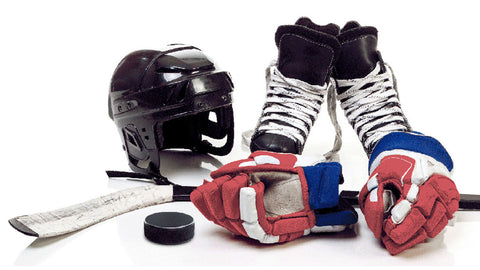



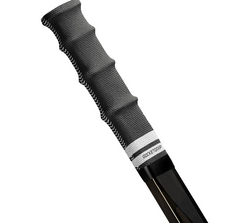 Achieving the perfect grip on your hockey stick is essential for optimizing stick handling and shooting accuracy.
Achieving the perfect grip on your hockey stick is essential for optimizing stick handling and shooting accuracy.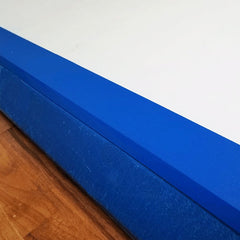


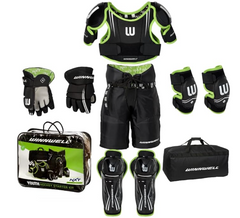


 A HUGE HIT! - Jenn R. / Verified Purchase Like many parents, we’re trying to keep our son occupied at home. This mini-rink is going to be a lifesaver! It’s only day one, and he’s already getting used to skating again after a month off the ice. Thank you so much! #norinknoproblem
A HUGE HIT! - Jenn R. / Verified Purchase Like many parents, we’re trying to keep our son occupied at home. This mini-rink is going to be a lifesaver! It’s only day one, and he’s already getting used to skating again after a month off the ice. Thank you so much! #norinknoproblem








